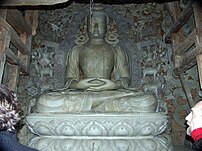
Image via Wikipedia
Meditation has a number of very important benefits, both to our minds and our bodies. With all these important benefits, you would think that everyone would meditate every day. One of the most frequent reasons people give for not engaging in daily meditation sessions is lack of time. Many people simply are too busy living their daily lives and making a living, and they feel they do not have the time and energy to devote to meditation.
That is where the one-minute meditation comes in. As the name implies, the one-minute meditation takes a mere 60 seconds, and even the busiest person can spare that much time.
The one-minute meditation is also one of the easiest to do. There are no mantras to repeat, no candles to burn, no complicated yoga positions. The one-minute meditation simply consists of taking three deep breaths.
Try this simple breathing exercise. Breathe in through your mouth, and then breathe instead through your nose. When you breathe through your mouth your chest will expand, while nose breathing expands your diaphragm and your abdomen instead. Breathing through your nose will cause the diaphragm to engage, bringing air much deeper into your lungs. This means that more oxygen is being delivered to your bloodstream and your organs, and this results in a greater level of relaxation.
That is why breath control is such a fundamental of meditation. At the extreme end of the spectrum are those religious leaders who can use meditation to slow their breathing almost to the point of imperceptibility. It is of course not necessary for the average person to take breathing control to this extreme, but learning how to breath properly can help us relax and get more out of even the shortest meditation session.
All you need to do to engage in a successful one-minute meditation is to close your eyes, let your thoughts drift away, and take three slow, deliberate and deep breaths through your nose. Pay attention to your breathing as you inhale and exhale each breath, and note how much better you feel after having done so.
This meditation exercise will of course not take you into a deep contemplative state of mind, nor will it allow you to commune with your inner child. The one-minute meditation will, however, allow you to relax and recharge, making it a perfect exercise for whenever you feel stressed out or overwhelmed by the day. The beauty of the one-minute meditation is that it can be done virtually anywhere – at the office, at home, at lunchtime, or even in your car. This one-minute recharging session can definitely help you get through a busy and stressful day.
It is a good idea to make this one-minute meditation a regular ritual. Try doing the one-minute meditation first thing every morning, or right before bedtime. Performing this simple exercise upon waking can help you charge the batteries and get ready for the day, while doing it at nighttime can relax you and get you ready for a restful night’s sleep. Making a habit out of something healthy, like the one-minute meditation, is certainly better than making a habit out of something harmful, like alcohol or cigarettes.
The one-minute meditation is perfect for those who feel they do not have time to meditate. This simple exercise can be used on its own, or combined with other, more sophisticated, meditation techniques. Try it for a few days. You may be wondering how you ever got along without it.




